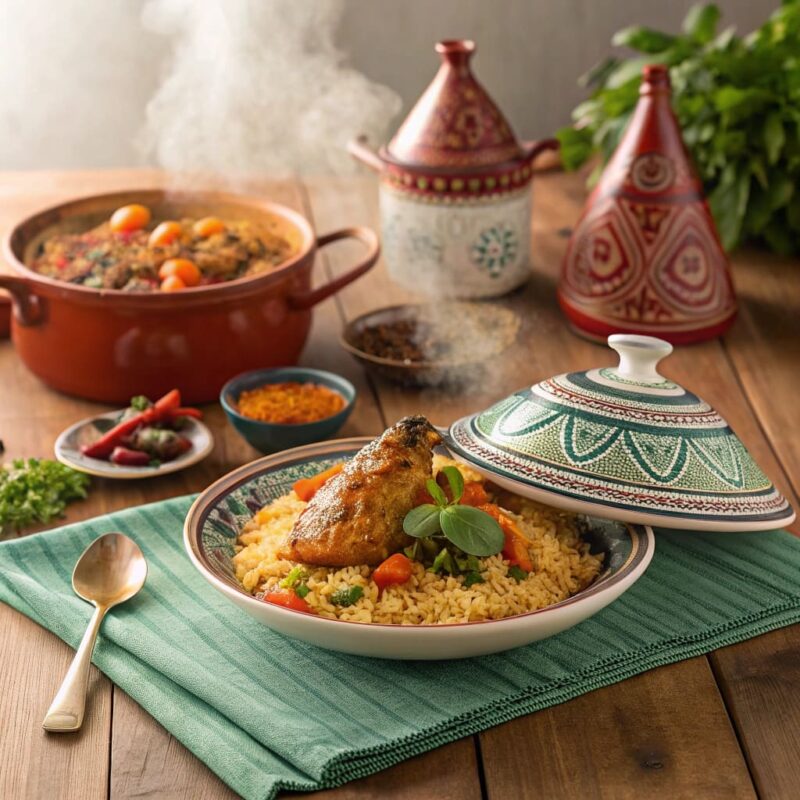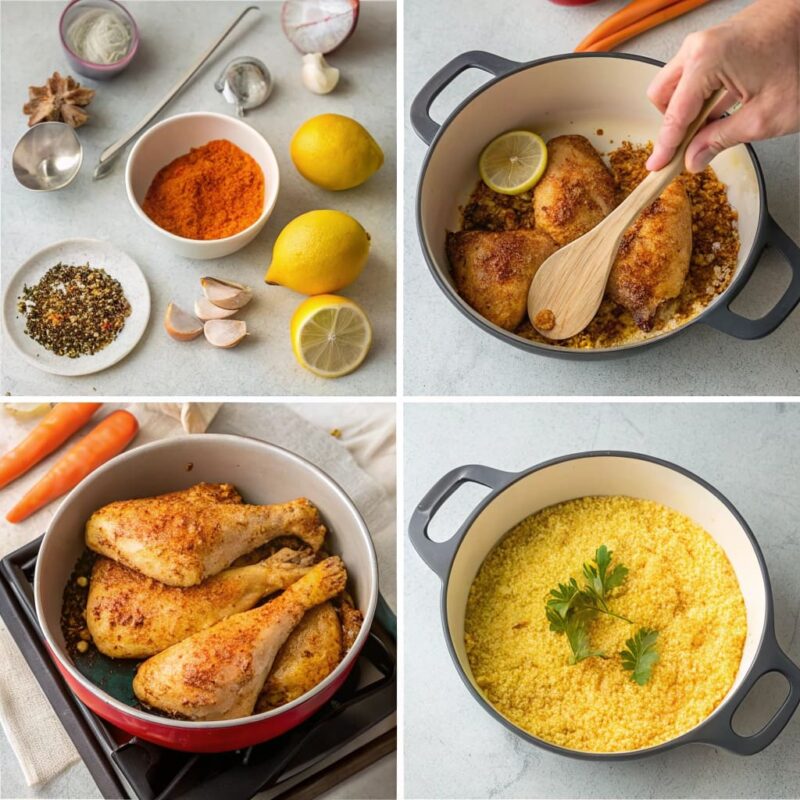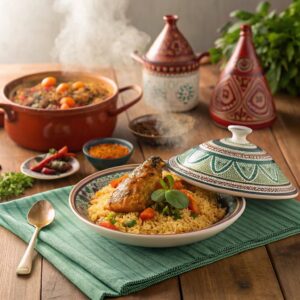
Moroccan cuisine is renowned for its rich flavors, vibrant spices, and comforting dishes. Among its many treasures, Moroccan chicken leg couscous stands out as a beloved classic. This dish brings together tender chicken legs, fluffy couscous, and a medley of vegetables, all infused with fragrant spices. It’s a feast for the senses and a true crowd-pleaser.
In this recipe, we’ll guide you step-by-step to prepare an authentic Moroccan chicken leg couscous right in your own kitchen. Whether you’re hosting a family gathering or simply craving a wholesome meal, this dish is sure to impress. Let’s dive into the history, ingredients, and preparation techniques that make this recipe so special.
Overview of Moroccan Couscous with Chicken Legs
Couscous is more than just a dish in Morocco—it’s a cultural symbol. Traditionally served during celebrations, family gatherings, and holidays, it represents hospitality and togetherness. Moroccan chicken leg couscous is particularly popular because it combines protein-rich chicken with hearty vegetables and flavorful spices, making it a balanced and satisfying meal.
What makes this dish exceptional is its ability to adapt to any occasion. Whether served as a humble weeknight dinner or as the centerpiece of a festive feast, it always feels special. The slow-cooked chicken legs are the highlight, delivering juicy, tender bites that soak up the aromatic sauce. Meanwhile, the couscous acts as the perfect base, absorbing all the rich flavors.
This recipe reflects Morocco’s culinary heritage, blending Berber traditions with influences from Arab, Mediterranean, and African cultures. It’s not just food—it’s a journey through history and flavor.
History and Cultural Significance of Couscous in Moroccan Cuisine
Couscous has been a staple of Moroccan cuisine for centuries, dating back to the Berbers, who are credited with its invention. Originally prepared using simple tools, it has evolved into a dish deeply rooted in tradition. Often served on Fridays, the Muslim holy day, couscous represents unity and gratitude.
The process of making couscous by hand is labor-intensive, yet it reflects Moroccan hospitality. It’s common for families to gather around a large communal dish, sharing meals as a symbol of connection.
Chicken legs, specifically, are favored for their affordability and flavor. In Moroccan households, they are often used in celebratory meals due to their rich taste and versatility. Combined with couscous, vegetables, and spices, they create a dish that embodies Moroccan comfort food.
Why Chicken Legs Are Ideal for This Recipe
When it comes to Moroccan chicken leg couscous, chicken legs are the star of the show for good reason. Their dark meat stays moist and flavorful during cooking, making them perfect for slow-cooked dishes. The bone-in structure adds depth to the broth, enhancing the dish’s overall richness.
For another Moroccan classic that features chicken, consider trying this Moroccan Chicken Tagine recipe, which offers a similar depth of flavor with a slightly different preparation style.
Ingredients and Preparation
Key Ingredients for Moroccan Chicken Leg Couscous
To create an authentic Moroccan chicken leg couscous, you’ll need a carefully curated mix of ingredients. Here’s what you’ll need:
Proteins
- 4–6 chicken legs (bone-in, skin-on for flavor)
Vegetables
- 2 carrots, peeled and cut into chunks
- 2 zucchini, sliced into thick rounds
- 1 turnip, diced
- 1 large onion, finely chopped
- 1 tomato, grated or chopped
- 1 can chickpeas (drained and rinsed)
Spices
- 1 teaspoon ground cumin
- 1 teaspoon ground coriander
- 1 teaspoon turmeric
- 1 teaspoon ground cinnamon
- ½ teaspoon smoked paprika
- ½ teaspoon ground ginger
- Salt and pepper to taste
Aromatics and Extras
- 3 tablespoons olive oil
- 4 cups chicken broth
- 1 bunch cilantro or parsley (for garnish)
- 1 cup dried apricots or raisins (optional for sweetness)
- ½ cup slivered almonds (optional for crunch)
For the Couscous
- 2 cups couscous
- 2 tablespoons butter or olive oil
- ½ teaspoon saffron threads (optional for color and flavor)
Role of Aromatic Spices in Moroccan Cuisine
Spices are the heart and soul of Moroccan cooking, and this recipe is no exception. The combination of cumin, cinnamon, turmeric, and ginger creates a warm, earthy flavor profile that defines this dish. These spices don’t just add taste—they also provide health benefits, from aiding digestion to reducing inflammation.
Cinnamon adds sweetness, balancing the savory notes, while turmeric gives the dish its golden hue. Paprika provides a smoky depth, and ginger offers a subtle warmth. Together, they transform simple ingredients into a fragrant masterpiece.
In Moroccan households, spice blends are often passed down through generations, reflecting family traditions and regional influences. By carefully layering these flavors, we can replicate that authentic taste at home.
For more ideas on how to pair your couscous, consider serving it alongside a refreshing Mediterranean cucumber salad to add a crisp, vibrant contrast to the rich and hearty flavors.
Selecting the Right Chicken Legs
Fresh vs. Frozen Chicken
Fresh chicken legs are ideal for this recipe because they retain moisture better during cooking. However, frozen chicken can work if properly thawed in advance. Always defrost chicken in the refrigerator overnight rather than at room temperature to maintain safety and quality.
Tips for Optimal Flavor and Texture
- Skin-on chicken: Adds richness and prevents drying out.
- Bone-in cuts: Provide deeper flavor during simmering.
- Marinate beforehand: Enhances taste and tenderness (we’ll cover this step next!).
Step-by-Step Cooking Instructions

Step 1: Marinating the Chicken Legs
The key to flavorful Moroccan chicken leg couscous lies in marinating the chicken. This step infuses the meat with spices, ensuring every bite bursts with flavor.
Creating the Marinade
To prepare the marinade, combine the following ingredients in a large mixing bowl:
- 3 tablespoons olive oil
- 1 teaspoon ground cumin
- 1 teaspoon ground coriander
- 1 teaspoon turmeric
- ½ teaspoon paprika
- ½ teaspoon ground ginger
- ½ teaspoon cinnamon
- Juice of 1 lemon
- 3 cloves garlic, minced
- Salt and pepper to taste
Whisk these ingredients until well blended. The olive oil helps coat the chicken, while the lemon juice tenderizes the meat. The spices add depth and warmth, making this marinade the backbone of the dish.
Marinating Tips for Maximum Flavor
- Coat the chicken thoroughly. Massage the marinade into the chicken legs, making sure every part is covered.
- Let it rest. For the best flavor, marinate the chicken for at least 1 hour. If time allows, refrigerate it overnight for deeper penetration of flavors.
- Bring to room temperature before cooking. Remove the chicken from the fridge 20 minutes before cooking to ensure even cooking.
Marinating not only enhances taste but also keeps the chicken juicy as it simmers in the stew.
Step 2: Preparing the Stew Base
Now that the chicken is marinated, it’s time to build the rich, aromatic base for the stew.
Building Layers of Flavor
- Heat 2 tablespoons of olive oil in a large pot or Dutch oven over medium heat.
- Add 1 finely chopped onion and sauté until soft and golden (about 5 minutes).
- Stir in 3 cloves of minced garlic and cook for another minute until fragrant.
Adding the Spices
Add the remaining spices directly to the pot:
- 1 teaspoon cumin
- 1 teaspoon turmeric
- ½ teaspoon paprika
- ½ teaspoon cinnamon
- Salt and pepper
Stir the spices into the onions and garlic, allowing them to bloom in the heat. This process releases their essential oils, intensifying the flavors.
Cooking the Chicken
- Place the marinated chicken legs into the pot and brown them on all sides. This step seals in the juices and adds a delicious crust.
- Once browned, pour in 4 cups of chicken broth and 1 grated tomato.
- Bring the mixture to a boil, then reduce the heat to low and let it simmer, covered, for 30 minutes.
The chicken will slowly cook, absorbing the aromatic flavors of the broth while staying tender.
Step 3: Cooking Vegetables and Legumes
Vegetables and legumes are what make Moroccan chicken leg couscous hearty and wholesome.
Timing and Techniques for Tender Vegetables
- Add the vegetables in stages, based on their cooking times:
- Carrots and turnips go in first, as they take longer to soften. Simmer for 10 minutes.
- Zucchini and chickpeas go in later, as they cook faster. Simmer for another 10–15 minutes.
- Taste and adjust seasoning if needed. The broth should be flavorful but balanced—rich, slightly sweet, and mildly spicy.
- For an added layer of sweetness, toss in a handful of dried apricots or raisins during the last 5 minutes of cooking.
By the end of this step, the vegetables should be fork-tender, and the stew should have thickened slightly, creating a luscious sauce.
Step 4: Steaming the Couscous
Couscous is the foundation of this dish, so it’s important to prepare it properly.
Traditional Steaming Method
- Place 2 cups of dry couscous in a large bowl and drizzle with 2 tablespoons of olive oil.
- Add ½ teaspoon of salt and mix well.
- Slowly pour 1 ½ cups of warm water over the couscous and fluff with a fork to separate the grains.
- Transfer the couscous to the top tier of a couscous steamer (known as a couscoussier). Place it above the simmering stew so it absorbs the steam and flavors.
- Steam for 15–20 minutes, fluffing occasionally to prevent clumping.
Quick Preparation Method
If you’re short on time, you can use instant couscous:
- Boil 1 ½ cups of water with a pinch of salt.
- Remove from heat and stir in 2 cups of couscous.
- Cover and let it sit for 5 minutes.
- Fluff with a fork and drizzle with olive oil or melted butter for added richness.
While the quick method is convenient, steaming produces fluffier, more authentic couscous.
Flavor Enhancements and Serving Suggestions
Adding Dried Fruits and Nuts
For an authentic Moroccan touch, incorporate dried fruits and nuts:
- Apricots and raisins: Add subtle sweetness that complements the savory broth.
- Almonds: Toasted almonds add crunch and visual appeal. Sprinkle them over the couscous before serving.
Pairing Couscous with Sauces
Traditional Moroccan condiments elevate the dish even further:
- Harissa: A spicy chili paste for those who enjoy heat.
- Preserved lemons: Add a tangy, citrusy burst that cuts through the richness.
Serve these condiments on the side, allowing guests to customize their plates.
Garnishing Ideas for a Stunning Presentation
Presentation matters, especially for a festive dish like this. Top your couscous with:
- Chopped parsley or cilantro for a pop of color.
- Lemon wedges for a zesty finish.
- Black or green olives for added flavor and visual contrast.
Tips for Perfect Moroccan Chicken Couscous
Secrets to Perfectly Steamed Couscous
Fluffy couscous is the hallmark of a great Moroccan chicken leg couscous dish. Achieving the perfect texture requires patience and technique.
- Use the right amount of water. Too little water leaves couscous dry, while too much makes it mushy. Stick to the recommended water-to-couscous ratio—1 ½ cups of water for every 2 cups of couscous.
- Fluff regularly. Whether you steam it traditionally or use instant couscous, always fluff it with a fork to separate the grains. This prevents clumping.
- Add butter or oil. Toss in a tablespoon of olive oil or butter after cooking to give the couscous a silky texture and enhance its flavor.
- Infuse with spices. For an extra layer of flavor, add saffron threads or a pinch of cinnamon while steaming.
The result? Light, airy grains that soak up the rich stew beautifully.
Common Mistakes to Avoid
Even seasoned cooks can make errors that affect the outcome of this dish. Here’s what to watch out for:
- Overcooking the chicken. Chicken legs should be tender but not falling apart. Simmer gently and check for doneness after 30–40 minutes.
- Overloading with vegetables. While veggies add bulk and nutrition, too many can overshadow the flavors of the chicken and broth. Stick to a balanced variety.
- Forgetting to season the couscous. Bland couscous can make the dish feel incomplete. Always season it lightly before serving.
- Skipping the garnish. Fresh herbs, nuts, and fruits aren’t just decorative—they add layers of flavor and texture that make the dish memorable.
By avoiding these pitfalls, you’ll ensure your couscous is a standout success.
Health Benefits of Moroccan Couscous
Nutritional Value of Ingredients
Moroccan chicken leg couscous isn’t just delicious—it’s also incredibly nutritious. Each ingredient contributes to a well-rounded, healthy meal:
- Chicken legs: Rich in protein, essential for muscle repair and growth. They also provide iron and zinc, which support immunity.
- Vegetables: Carrots, zucchini, and turnips are loaded with vitamins A and C, fiber, and antioxidants, promoting better digestion and overall health.
- Chickpeas: A great source of plant-based protein, fiber, and iron. They help keep you full and energized.
- Spices: Turmeric and ginger have anti-inflammatory properties, while cinnamon may help regulate blood sugar.
- Couscous: Made from semolina wheat, it’s a healthy carbohydrate with a low glycemic index, making it suitable for balanced blood sugar levels.
Why Couscous is a Healthy Carb Option
Unlike heavy grains or pasta, couscous is light and easy to digest. It provides:
- Low fat content: Making it ideal for weight management.
- Quick energy: Its carbohydrates offer sustained energy without causing sugar spikes.
- Fiber boost: Especially when combined with vegetables and legumes, supporting gut health.
This dish is proof that comfort food can also be nourishing!
Moroccan chicken leg couscous is more than just a meal—it’s a celebration of culture, flavor, and tradition. With its tender chicken, aromatic spices, and fluffy couscous, it’s a dish that brings people together and leaves a lasting impression.
Whether you’re cooking for family, friends, or just yourself, this recipe is versatile enough for any occasion. Don’t hesitate to get creative—add dried fruits, nuts, or your favorite vegetables to make it your own.
Ready to try this mouthwatering dish? Grab your ingredients, follow the steps, and let your kitchen fill with the warm, inviting aromas of Morocco.
FAQs
1. What can I use instead of chicken legs?
You can substitute chicken thighs or drumsticks for similar results. For a lighter version, chicken breasts can work, but they may not be as juicy.
2. How can I make this dish vegetarian?
Replace the chicken with chickpeas, lentils, or tofu. Increase the variety of vegetables for added bulk and flavor.
3. Is it necessary to steam the couscous, or can I use instant couscous?
While steaming gives a more authentic texture, instant couscous is perfectly fine for quick preparation. Just be sure to fluff it well and season it properly.
4. Can this dish be made ahead and reheated?
Yes! Moroccan chicken couscous reheats beautifully. Store it in an airtight container in the fridge and gently warm it on the stove, adding a splash of broth if needed.
5. What side dishes pair well with Moroccan couscous?
Serve it with a side of flatbread, a crisp cucumber salad, or roasted eggplant. Harissa and preserved lemons also make excellent condiments.

Authentic Moroccan Chicken Leg Couscous Recipe
Ingredients
For the Chicken Stew
- 4 –6 chicken legs bone-in, skin-on for extra flavor
- 2 tbsp olive oil
- 1 large onion finely chopped
- 3 cloves garlic minced
- 1 grated tomato
- 2 carrots peeled and cut into chunks
- 2 zucchinis sliced into thick rounds
- 1 turnip diced
- 1 can chickpeas drained and rinsed
- 4 cups chicken broth
Spices & Seasoning
- 1 tsp ground cumin
- 1 tsp turmeric
- 1 tsp ground cinnamon
- ½ tsp smoked paprika
- ½ tsp ground ginger
- Salt and pepper to taste
- 1 tsp ground coriander
- 1 tbsp lemon juice
- 1 cup dried apricots or raisins optional for sweetness
- ½ cup slivered almonds optional for garnish
- Chopped parsley or cilantro for garnish
For the Couscous
- 2 cups couscous
- 2 tbsp butter or olive oil
- ½ tsp saffron threads optional for color and flavor
- 1 ½ cups warm water or broth
Instructions
Step 1: Marinate the Chicken
- In a bowl, mix olive oil, cumin, coriander, turmeric, cinnamon, paprika, ginger, lemon juice, salt, and pepper.
- Rub the marinade onto the chicken legs and let them sit for at least 1 hour (or overnight for best flavor).
Step 2: Prepare the Stew Base
- Heat 2 tbsp olive oil in a large Dutch oven or pot over medium heat.
- Add chopped onion and garlic, sauté until soft and golden.
- Stir in grated tomato and spices (cumin, turmeric, paprika, cinnamon), letting them cook for 2 minutes.
- Place the marinated chicken legs in the pot and brown on all sides.
Step 3: Simmer with Vegetables
- Pour in chicken broth and bring to a boil.
- Reduce heat, cover, and let simmer for 30 minutes.
- Add carrots, turnips, and cook for 10 minutes.
- Stir in zucchini, chickpeas, and dried fruit (if using). Simmer for another 10–15 minutes.
- Taste and adjust salt and seasoning.
Step 4: Prepare the Couscous
Traditional Steaming Method:
- Place couscous in a bowl, drizzle with olive oil, and fluff with a fork.
- Transfer to a couscoussier steamer and steam for 15–20 minutes above the simmering stew.
- Fluff occasionally for light, airy texture.
Quick Method:
- Boil 1 ½ cups water or broth, remove from heat.
- Stir in couscous, cover, and let sit for 5 minutes.
- Fluff with a fork, drizzle with olive oil or butter.
- Serving Suggestions
- Serve the stew over a bed of couscous.
- Garnish with chopped parsley, almonds, and lemon wedges.
- Pair with harissa, preserved lemons, or a fresh Mediterranean salad.
Storage & Reheating
- Refrigeration: Store in an airtight container for up to 3 days.
- Freezing: Freeze chicken and vegetables separately for up to 3 months.
- Reheating: Warm gently on the stove, adding broth if needed.
Nutrition Per Serving
- Calories: 450
- Protein: 30g
- Carbs: 55g
- Fat: 12g
- Fiber: 6g
